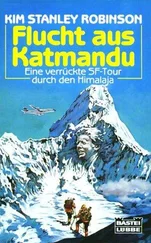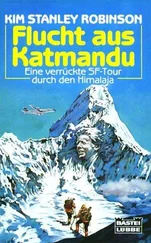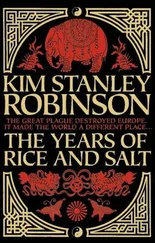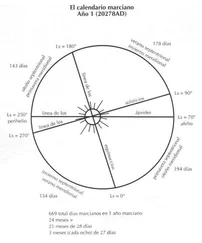But she was persistent, even adamant. “We have to put the Gulf Stream action to one side, and take a look at all the rest of it,” she commanded. “Chase is going to need that from us to go forward.”
Back in his office, therefore, Frank would sit at his desk, staring at his list of Things To Do. But all in a vain attempt to take his mind off Caroline.
Ordinarily the list would be enough to distract anyone. Its length and difficulty made it all by itself a kind of blow to the head. It induced an awe so great that it resembled apathy. They had done so much and yet there was so much left to do. And as more disasters blasted into the world, their Things To Do list would lengthen. It would never shorten. They were like the Dutch boy sticking his finger into the failing dike. What had happened to Khembalung was going to happen everywhere.
But there would still be land above water. There would still be things to be done. One had to try.
Caroline had spoken of her Plan B as if she had confidence in it. She must have had a place to go, a bank account, that sort of thing.
Frank checked out the figures from the oceanography group. The oceans covered about seventy percent of the globe. About two hundred million square kilometers, therefore, and in the wake of the first really big chunks of the West Antarctic Ice Sheet floating away, sea level was reported to have risen about twenty centimeters. The oceanographers had been measuring sea level rise a millimeter at a time, mostly from water warming up and expanding, so they were blown away and spoke of this twenty centimeters’ rise as of a Noah’s flood. Kenzo was simply bursting with amazement and pride.
Back-of-the-envelope calculation: .2 meters times the two hundred million square kilometers, was that forty thousand cubic kilometers? A lot of water. Measurements from the last few years had Antarctica losing a hundred and fifty cubic kilometers a year, with thirty to fifty more coming off Greenland. So, now about two hundred years’ worth had come off in one year. No wonder they were freaking out. The difference no doubt lay in the fact that the melt before had been actual melting, whereas now what was happening was a matter of icebergs breaking off their perch and sliding down into the ocean. Obviously it made a big difference in how fast it could happen.
Frank brought the figures in with him to the meeting of Diane’s strategic group scheduled for that afternoon, and listened to the others make their presentations. They were interesting talks, if daunting. They took his mind off Caroline, one had to say that. At least most of the time.
At the end of the talks, Diane described her sense of the situation. For her, there was a lot that was good news. First, Phil Chase was certain to be more supportive of NSF, and of science in general, than his predecessor had been. Second, the salting of the North Atlantic appeared to be having the effect they had hoped for: the Gulf Stream was now running at nearly its previous strength up into the Norwegian and Greenland Seas, following its earlier path in a manner that seemed to indicate the renewed pattern was, for now, fairly robust. They were still collecting data on the deeper part of the thermohaline circulation, which ran southward underneath the northerly flow of the Gulf Stream. If the southward undercurrent was running strong, they might be okay there.
“There’s so much surface pressure northward,” Kenzo said. “Maybe all we’ll have to do from now on is to monitor the salinity and the currents. We might be able to intervene early enough in any stall process that we wouldn’t need as much salt as we applied last fall. Maybe a certain percentage of the retiring oil fleet could be mothballed, in case we needed a salt fleet to go up there again and make another application.”
“It would take a change in thinking,” Diane said. “Up until now, people have only wanted to pay for disasters after they’ve happened, to make sure the pay-out was really necessary.”
Kenzo said, “But now the true costs of that strategy are becoming clear.”
“When it’s too late,” Edgardo added, his usual refrain.
Diane wrinkled her nose at Edgardo, as she often did, and made her usual rejoinder; they had no choice but to proceed from where they were now. “So, let’s follow up on that one. It would have to be a kind of insurance model, or a hedge fund. Maybe the reinsurance industry will be trying to impose something like that on the rest of the economy anyway. We’ll talk to them.”
She moved on to the West Antarctic Ice Sheet situation. One of Kenzo’s oceanographer colleagues gave them a presentation on the latest, showing with maps and satellite photos the tabular superbergs that had detached and slipped off their underwater perch and floated away.
Diane said, “I’d like some really good 3-D graphics on this, to show the new president and Congress, and the public too.”
“All very well,” Edgardo said, “but what can we do about it, aside from telling people it’s coming?”
Not much; or nothing. Even if they somehow managed to lower the level of atmospheric carbon dioxide, and therefore the air temperatures, the already-rising ocean temperatures would be slow to follow. There was a continuity effect.
So they couldn’t stop the WAIS from detaching.
They couldn’t lower the rising sea level that resulted.
And they couldn’t de-acidify the ocean.
This last was a particularly troubling problem. The CO 2they had introduced into the atmosphere had been partially taken up by the ocean; the absorption rate now was about three billion tons of carbon a year into the ocean, and one estimate of the total uptake since the industrial revolution was four hundred billion tons. As a result, the ocean had become measurably more acidic, going from 8.2 to 8.1 on the pH scale, which was a logarithmic scale, so that the 0.1 shift meant thirty percent more hydrogen ions in the water. It was felt that certain species of phytoplankton would have their very thin calcium shells in effect eaten away. They would die, a number of species would go extinct, and these very species constituted a big fraction of the bottom of the ocean’s food chain.
But de-acidifying the ocean was not an option. There were fairly arcane chemistry reasons why it was easier for sea water to become more acidic than to become more basic. A Royal Society paper had calculated, for the sake of estimating the scale of the problem, that if they mined and crushed exposed limestone and marble in the British Isles, “features such as the White Cliffs of Dover would be rapidly consumed,” because it would take sixty square kilometers of limestone mined a hundred meters deep, every year, just to hold the status quo. All at a huge carbon cost for the excavations, of course, exacerbating the very problem they were trying to solve. But this was just a thought experiment anyway. It wouldn’t work; it was an unmitigatable problem.
And that afternoon, as they went down Diane’s list together, they saw that almost all of the climate and environmental changes they were seeing, or could see coming, were not susceptible to mitigation. Their big success of the fall, the restarting of the thermohaline cycle, had been an anomaly in that sense. The Gulf Stream had rested so closely to a tipping point in its action that humans had, by an application at the largest industrial scale they commanded, managed to tip that balance—at least temporarily. And as a result (maybe) the last month on the East Coast had been markedly warmer than the previous December had been. Perhaps they had even escaped the Youngest Dryas. So now, in one of those quick leaps that humans were prone to make (although science was not), people were talking about the climate problem as if it were something that they could terraform their way out of, or even had solved already!
Читать дальше
Конец ознакомительного отрывка
Купить книгу












